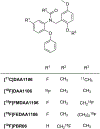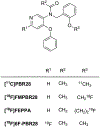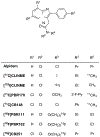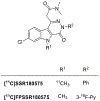Essential Principles and Recent Progress in the Development of TSPO PET Ligands for Neuroinflammation Imaging
- PMID: 35352645
- PMCID: PMC10080361
- DOI: 10.2174/0929867329666220329204054
Essential Principles and Recent Progress in the Development of TSPO PET Ligands for Neuroinflammation Imaging
Abstract
The translocator protein 18kDa (TSPO) is expressed in the outer mitochondrial membrane and is implicated in several functions, including cholesterol transport and steroidogenesis. Under normal physiological conditions, TSPO is present in very low concentrations in the human brain but is markedly upregulated in response to brain injury and inflammation. This upregulation is strongly associated with activated microglia. Therefore, TSPO is particularly suited for assessing active gliosis associated with brain lesions following injury or disease. For over three decades, TSPO has been studied as a biomarker. Numerous radioligands for positron emission tomography (PET) that target TSPO have been developed for imaging inflammatory progression in the brain. Although [11C]PK11195, the prototypical first-generation PET radioligand, is still widely used for in vivo studies, mainly now as its single more potent R-enantiomer, it has severe limitations, including low sensitivity and poor amenability to quantification. Second-generation radioligands are characterized by higher TSPO specific signals but suffer from other drawbacks, such as sensitivity to the TSPO single nucleotide polymorphism (SNP) rs6971. Therefore, their applications in human studies have the burden of needing to genotype subjects. Consequently, recent efforts are focused on developing improved radioligands that combine the optimal features of the second generation with the ability to overcome the differences in binding affinities across the population. This review presents essential principles in the design and development of TSPO PET ligands and discusses prominent examples among the main chemotypes.
Keywords: PET; TSPO; diagnostic marker; drug development; imaging; neuroinflammation; radioligand.
Copyright© Bentham Science Publishers; For any queries, please email at epub@benthamscience.net.
Conflict of interest statement
CONFLICT OF INTEREST
The authors declares no conflict of interest, financial or otherwise.
Figures














Similar articles
-
TSPO Radioligands for Neuroinflammation: An Overview.Molecules. 2024 Sep 5;29(17):4212. doi: 10.3390/molecules29174212. Molecules. 2024. PMID: 39275061 Free PMC article. Review.
-
Synthesis and evaluation of translocator 18 kDa protein (TSPO) positron emission tomography (PET) radioligands with low binding sensitivity to human single nucleotide polymorphism rs6971.ACS Chem Neurosci. 2014 Oct 15;5(10):963-71. doi: 10.1021/cn500138n. Epub 2014 Aug 25. ACS Chem Neurosci. 2014. PMID: 25123416 Free PMC article.
-
Microglial Positron Emission Tomography Imaging In Vivo : Positron Emission Tomography Radioligands: Utility in Research and Clinical Practice.Adv Neurobiol. 2024;37:579-589. doi: 10.1007/978-3-031-55529-9_32. Adv Neurobiol. 2024. PMID: 39207714 Review.
-
Preclinical evaluation of (S)-[18F]GE387, a novel 18-kDa translocator protein (TSPO) PET radioligand with low binding sensitivity to human polymorphism rs6971.Eur J Nucl Med Mol Imaging. 2021 Dec;49(1):125-136. doi: 10.1007/s00259-021-05495-w. Epub 2021 Aug 18. Eur J Nucl Med Mol Imaging. 2021. PMID: 34405276 Free PMC article.
-
Acetamidobenzoxazolone scaffold as a promising translocator protein (18 kDa, TSPO) marker for neuroinflammation imaging: Advancement in last decennial period.Drug Dev Res. 2022 Nov;83(7):1519-1533. doi: 10.1002/ddr.21989. Epub 2022 Sep 8. Drug Dev Res. 2022. PMID: 36074736 Review.
Cited by
-
Refining seizure foci localization: the potential of TSPO-PET.Acta Epileptol. 2025 Aug 21;7(1):41. doi: 10.1186/s42494-025-00234-2. Acta Epileptol. 2025. PMID: 40836311 Free PMC article. Review.
-
Association of white matter injury and neuroinflammation in the post-acute phase after ischemic stroke using [18F]FEPPA-PET/MRI.EJNMMI Res. 2025 Jul 23;15(1):91. doi: 10.1186/s13550-025-01288-6. EJNMMI Res. 2025. PMID: 40699407 Free PMC article.
-
Neuroinflammation: The Abused Concept.ASN Neuro. 2023 Jan-Dec;15:17590914231197523. doi: 10.1177/17590914231197523. ASN Neuro. 2023. PMID: 37647500 Free PMC article. Review.
-
Synaptic changes in psychiatric and neurological disorders: state-of-the art of in vivo imaging.Neuropsychopharmacology. 2024 Nov;50(1):164-183. doi: 10.1038/s41386-024-01943-x. Epub 2024 Aug 12. Neuropsychopharmacology. 2024. PMID: 39134769 Free PMC article. Review.
-
Current advances in the structure-activity relationship (SAR) analysis of the old/new 18-kDa translocator protein ligands.Mol Divers. 2025 Jun;29(3):2639-2689. doi: 10.1007/s11030-024-10963-0. Epub 2024 Dec 4. Mol Divers. 2025. PMID: 39630364 Review.
References
-
- Papadopoulos V; Baraldi M; Guilarte TR; Knudsen TB; Lacapère JJ; Lindemann P; Norenberg MD; Nutt D; Weizman A; Zhang MR; Gavish M Translocator protein (18kDa): New nomenclature for the peripheral-type benzodiazepine receptor based on its structure and molecular function. Trends Pharmacol. Sci, 2006, 27(8), 402–409. 10.1016/j.tips.2006.06.005 - DOI - PubMed
Publication types
MeSH terms
Substances
Grants and funding
- Z01 MH002793/ImNIH/Intramural NIH HHS/United States
- ZIA MH002793/ImNIH/Intramural NIH HHS/United States
- PRIN 2017MT3993/Italian Ministero dell’Istruzione, dell’Università e della Ricerca (MIUR), Progetti di Ricerca di Interesse Nazionale
- ZIA MH002793 /National Institutes of Health (National Institute of Mental Health)
LinkOut - more resources
Full Text Sources

